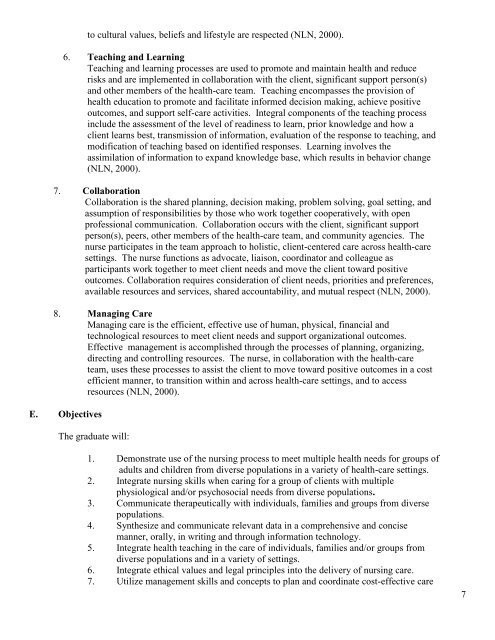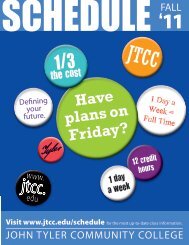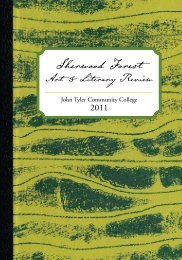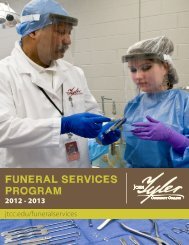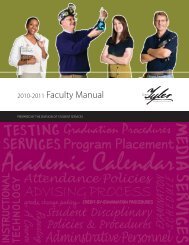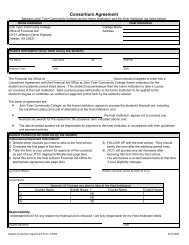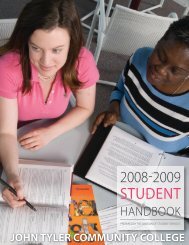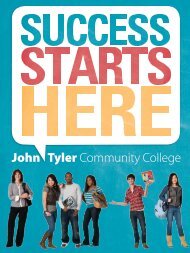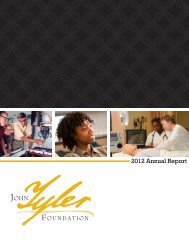Nursing Student Handbook - John Tyler Community College
Nursing Student Handbook - John Tyler Community College
Nursing Student Handbook - John Tyler Community College
Create successful ePaper yourself
Turn your PDF publications into a flip-book with our unique Google optimized e-Paper software.
to cultural values, beliefs and lifestyle are respected (NLN, 2000).<br />
6. Teaching and Learning<br />
Teaching and learning processes are used to promote and maintain health and reduce<br />
risks and are implemented in collaboration with the client, significant support person(s)<br />
and other members of the health-care team. Teaching encompasses the provision of<br />
health education to promote and facilitate informed decision making, achieve positive<br />
outcomes, and support self-care activities. Integral components of the teaching process<br />
include the assessment of the level of readiness to learn, prior knowledge and how a<br />
client learns best, transmission of information, evaluation of the response to teaching, and<br />
modification of teaching based on identified responses. Learning involves the<br />
assimilation of information to expand knowledge base, which results in behavior change<br />
(NLN, 2000).<br />
7. Collaboration<br />
Collaboration is the shared planning, decision making, problem solving, goal setting, and<br />
assumption of responsibilities by those who work together cooperatively, with open<br />
professional communication. Collaboration occurs with the client, significant support<br />
person(s), peers, other members of the health-care team, and community agencies. The<br />
nurse participates in the team approach to holistic, client-centered care across health-care<br />
settings. The nurse functions as advocate, liaison, coordinator and colleague as<br />
participants work together to meet client needs and move the client toward positive<br />
outcomes. Collaboration requires consideration of client needs, priorities and preferences,<br />
available resources and services, shared accountability, and mutual respect (NLN, 2000).<br />
8. Managing Care<br />
Managing care is the efficient, effective use of human, physical, financial and<br />
technological resources to meet client needs and support organizational outcomes.<br />
Effective management is accomplished through the processes of planning, organizing,<br />
directing and controlling resources. The nurse, in collaboration with the health-care<br />
team, uses these processes to assist the client to move toward positive outcomes in a cost<br />
efficient manner, to transition within and across health-care settings, and to access<br />
resources (NLN, 2000).<br />
E. Objectives<br />
The graduate will:<br />
1. Demonstrate use of the nursing process to meet multiple health needs for groups of<br />
adults and children from diverse populations in a variety of health-care settings.<br />
2. Integrate nursing skills when caring for a group of clients with multiple<br />
physiological and/or psychosocial needs from diverse populations.<br />
3. Communicate therapeutically with individuals, families and groups from diverse<br />
populations.<br />
4. Synthesize and communicate relevant data in a comprehensive and concise<br />
manner, orally, in writing and through information technology.<br />
5. Integrate health teaching in the care of individuals, families and/or groups from<br />
diverse populations and in a variety of settings.<br />
6. Integrate ethical values and legal principles into the delivery of nursing care.<br />
7. Utilize management skills and concepts to plan and coordinate cost-effective care<br />
7


